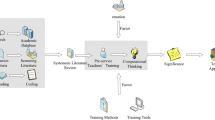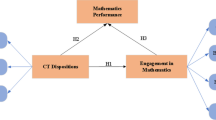Abstract
The purpose of this study was to explore the teaching–learning process of informatics education in South Korea, where an informatics education initiative was recently announced for K-12 education. Based on this initiative, this study aimed to investigate the effect of academic self-efficacy, teacher support, and a deep approach to learning computational thinking. The participants were 84 freshman students at a lower secondary school enrolled in a regular informatics class during Spring 2018. Partial least squares structural equation modeling (PLS-SEM) was employed to analyze the data. The key findings were as follows: first, academic self-efficacy and teacher support had a significant influence on a deep approach to learning. Second, academic self-efficacy and a deep approach to learning had a significant influence on computational thinking. This study suggests implications for enhancing computational thinking skills in informatics in secondary education.




Similar content being viewed by others
Data availability
Research data were gathered through a questionnaire. Participation was voluntary and participants had the option to abort at any time. Data were anonymized prior to data analysis and storage. The data can be obtained by sending a request e-mail to the corresponding author.
References
Ary, D., Jacobs, L. C., & Razavieh, A. (2002). Introduction to research in education (6th ed.). Wadsworth Group.
Avcu, Y. E., & Ayverdi, L. (2020). Examination of the computer programming self-efficacy’s prediction towards the computational thinking skills of the gifted and talented students. International Journal of Educational Methodology, 6(2), 259–270.
Baeten, M., Kyndt, E., Struyven, K., & Dochy, F. (2010). Using student-centred learning environments to stimulate deep approaches to learning: Factors encouraging or discouraging their effectiveness. Educational Research Review, 5(3), 243–260.
Bandura, A. (1977). Self-efficacy: Toward a unifying theory of behavioral change. Psychological Review, 84(2), 191–215.
Bandura, A. (1986). Social foundations of thought and action: Social foundations of thought and action. Prentice-Hall.
Bandura, A. (1997). Self-efficacy: The exercise of control. W. H. Freeman.
Barr, V., & Stephenson, C. (2011). Bringing computational thinking to K-12: What is involved and what is the role of the computer science education community? Inroads, 2(1), 48–54.
Biggs, J. B. (1993). From theory to practice: A cognitive systems approach. Higher Education Research and Development, 12(1), 73–85.
Biggs, J. (1994). Student learning research and theory: Where do we currently stand. Improving student learning: Theory and practice, pp. 1–19.
Biggs, J. (1996). Enhancing teaching through constructive alignment. Higher Education, 32(3), 347–364.
Biggs, J. (2003). Teaching for Quality Learning at University: What the Student Does. The Society for research into Higher Education and Open University Press.
Biggs, J., Kember, D., & Leung, D. Y. (2001). The revised two-factor study process questionnaire: R-SPQ-2F. British Journal of Educational Psychology, 71(1), 133–149.
Brennan, K., & Resnick, M. (2012). New frameworks for studying and assessing the development of computational thinking. In Proceedings of the 2012 annual meeting of the American Educational Research Association, Vancouver, Canada (Vol. 1, p. 25).
Bowen, J. A. (2012). Teaching naked: How moving technology out of your college classroom will improve student learning. John Wiley & Sons.
Campbell, D. T., & Fiske, D. W. (1959). Convergent and discriminant validity by the multitrait-multimethod matrix. Psychological Bulletin, 56(2), 81–105.
Chan, K. W. (2010). The Role of Epistemological Beliefs in Hong Kong Pre-service Teachers’ Learning. The Asia-Pacific Education Researcher, 19(1), 7–24.
Chin, W. W. (1998). The partial least squares approach to structural equation modeling. Modern Methods for Business Research, 295(2), 295–336.
Cohen, J. (1992). A Power Primer. Psychological Bulletin, 112, 115–159.
Cronbach, L. J. (1951). Coefficient alpha and the internal structure of tests. Psychometrika, 16(3), 297–334.
Cybinski, P., & Selvanathan, S. (2005). Learning experience and learning effectiveness in undergraduate statistics: Modeling performance in traditional and flexible learning environments. Decision Sciences Journal of Innovative Education, 3(2), 251–271.
Dagiene, V., & Stupuriene, G. (2016). Informatics concepts and computational thinking in K-12 education: A Lithuanian perspective. Journal of Information Processing, 24(4), 732–739.
Dijkstra, T. K., & Henseler, J. (2015). Consistent Partial Least Squares Path Modeling. MIS Quarterly, 39(2), 297–316.
Diseth, Å. (2002). The relationship between intelligence, approaches to learning and academic achievement. Scandinavian Journal of Educational Research, 46(2), 219–230.
Eccles, J. S., & Wigfield, A. (2002). Motivational beliefs, values, and goals. Annual Review of Psychology, 53(1), 109–132.
Fornell, C., & Larcker, D. F. (1981). Evaluating Structural Equation Models with Unobservable Variables and Measurement Error. Journal of Marketing Research, 18(1), 39–50.
Grover, S., & Pea, R. (2013). Computational thinking in K–12: A review of the state of the field. Educational Researcher, 42(1), 38–43.
Gutiérrez, M., Tomás, J. M., Romero, I., & Barrica, J. M. (2017). Perceived social support, school engagement and satisfaction with school. Revista De Psicodidáctica (english Ed.), 22(2), 111–117.
Hair, J. F., Hult, T. M., Ringle, C. M., & Sarstedt, M. (2017). A primer on partial least squares structural equation modeling. Thousand Oakes.
Hendrickx, M. M., Mainhard, M. T., Boor-Klip, H. J., Cillessen, A. H., & Brekelmans, M. (2016). Social dynamics in the classroom: Teacher support and conflict and the peer ecology. Teaching and Teacher Education, 53, 30–40.
Henseler, J., Ringle, C. M., & Sarstedt, M. (2015). A new criterion for assessing discriminant validity in variance-based structural equation modeling. Journal of the Academy of Marketing Science, 43(1), 115–135.
Jackson, D. (2006). Software abstractions: Logic, language, and analysis. MA: MIT Press.
Jackson, D. (2012b). Software abstractions: Logic, language, and analysis, 2nd edn. MIT Press, Cambridge.
Joo, Y. J., & Ko, K. Y. (2016). The effects of achievement motivation, quality of teaching and learning, students’ approaches to learning and peer interaction on outcomes of collaborative learning. Journal of Learner-Centered Curriculum and Instruction, 16(3), 85–103.
Kafai, Y., Searle, K., Martinez, C., & Brayboy, B. (2014). Ethnocomputing with electronic textiles: Culturally responsive open design to broaden participation in computing in American indian youth and communities. In Proceedings of the 45th ACM technical symposium on Computer science education (pp. 241–246). ACM.
Karagiannopoulou, E., & Milienos, F. S. (2015). Testing two path models to explore relationships between students’ experiences of the teaching-learning environment, approaches to learning and academic achievement. Educational Psychology, 35(1), 26–52.
Ketenci, T., Calandra, B., Margulieux, L., & Cohen, J. (2019). The Relationship Between Learner Characteristics and Student Outcomes in a Middle School Computing Course: An Exploratory Analysis Using Structural Equation Modeling. Journal of Research on Technology in Education, 51(1), 63–76.
Kember, D., Biggs, J., & Leung, D. Y. (2004). Examining the multidimensionality of approaches to learning through the development of a revised version of the Learning Process Questionnaire. British Journal of Educational Psychology, 74(2), 261–279.
Kim, J., Chung, H., & Lee, W. (2010). A Comparative study of high school informatics curriculum between Korea and Japan. Korean Journal of Comparative Education, 20(4), 129–151.
Kishton, J. M., & Widaman, K. F. (1994). Unidimensional versus domain representative parceling of questionnaire items: An empirical example. Educational and Psychological Measurement, 54(3), 757–765.
Kizilgunes, B., Tekkaya, C., & Sungur, S. (2009). Modeling the relations among students’ epistemological beliefs, motivation, learning approach, and achievement. The Journal of Educational Research, 102(4), 243–256.
Kline, R. B. (2010). Principles and practice of structural equation modeling (3rd ed.). The Guilford Press.
Korkmaz, Ö., Çakir, R., & Özden, M. Y. (2017). A validity and reliability study of the Computational Thinking Scales (CTS). Computers in Human Behavior, 72, 558–569.
Kumar, N. (2005). LEGO robots and AI. Annual Joint Conference Integrating Technology into Computer Science Education.
Mannila, L., Dagiene, V., Demo, B., Grgurina, N., Mirolo, C., Rolandsson, L., & Settle, A. (2014). Computational thinking in K-9 education. In Proceedings of the working group reports of the 2014 on innovation & technology in computer science education conference (pp. 1–29). ACM.
McShannon, J., & Hynes, P. (2005). Student achievement and retention: Can professional development programs help faculty GRASP it? The Journal of Faculty Development, 20(2), 87–93.
Miller, L. D., Soh, L. K., Chiriacescu, V., Ingraham, E., Shell, D. F., Ramsay, S., & Hazley, M. P. (2013). Improving learning of computational thinking using creative thinking exercises in CS-1 computer science courses. In 2013 IEEE Frontiers in education conference (FIE) (pp. 1426–1432). IEEE.
Nunnally, J. C., & Bernstein, I. H. (1994). Psychometric theory. McGraw-Hill.
OECD. (2010). PISA 2009 results: Executive summary. OECD.
Peterson, P. L., Swing, S. R., Braverman, M. T., & Buss, R. R. (1982). Students’ aptitudes and their reports of cognitive processes during direct instruction. Journal of Educational Psychology, 74(4), 535.
Papinczak, T., Young, L., Groves, M., & Haynes, M. (2008). Effects of a metacognitive intervention on students’ approaches to learning and self-efficacy in a first year medical course. Advances in Health Sciences Education, 13(2), 213–232.
Pintrich, P. R., & De Groot, E. V. (1990). The implications of learning theories to assessment and instructional scaffolding techniques. Journal of Educational Psychology, 82(1), 33–40.
Resnick, M. (2007). Sowing the seeds for a more creative society. Learning & Leading with Technology, 35(4), 18–22.
Sarıtepeci, M., & Durak, H. (2017). Analyzing the effect of block and robotic coding activities on computational thinking in programming education. Educational research and practice, 490–501.
Shell, D. F., Brooks, D. W., Trainin, G., Wilson, K. M., Kauffman, D. F., & Herr, L. M. (2010). The unified learning model. The unified learning model (pp. 1–4). Springer.
Schunk, D. H. (1991). Self-efficacy and academic motivation. Educational Psychologist, 26(3–4), 207–231.
Sysło, M. M., & Kwiatkowska, A. B. (2013). Informatics for all high school students. International conference on informatics in schools: Situation, evolution, and perspectives (pp. 43–56). Springer.
The Korea Ministry of Education. (2015). The revised of 2015 standards for informatics education. The Ministry of Education.
Thomas, C. R., & Gadbois, S. A. (2007). Academic self-handicapping: The role of self-concept clarity and students’ learning strategies. British Journal of Educational Psychology, 77(1), 101–119.
Torsheim, T., Wold, B., & Samdal, O. (2000). The teacher and classmate support scale: Factor structure, test-retest reliability and validity in samples of 13-and 15-year-old adolescents. School Psychology International, 21(2), 195–212.
Tort, F., & Drot-Delange, B. (2013). Informatics in the French secondary curricula: Recent moves and perspectives. International conference on informatics in schools: situation, evolution, and perspectives (pp. 31–42). Springer.
Villalba-Condori, K. O., Cuba-Sayco, S. E. C., Chávez, E. P. G., Deco, C., & Bender, C. (2018). Approaches of learning and computational thinking in students that get into the computer sciences career. In Proceedings of the sixth international conference on technological ecosystems for enhancing multiculturality (pp. 36–40).
Voogt, J., Fisser, P., Good, J., Mishra, P., & Yadav, A. (2015). Computational thinking in compulsory education: Towards an agenda for research and practice. Education and Information Technologies, 20(4), 715–728.
Wing, J. M. (2006). Computational thinking. Communications of the ACM, 49(3), 33–35.
Wing, J. M. (2008). Computational thinking and thinking about computing. Philosophical Transactions of the Royal Society a: Mathematical, Physical and Engineering Sciences, 366(1881), 3717–3725.
Yadav, A., Mayfield, C., Zhou, N., Hambrusch, S., & Korb, J. T. (2014). Computational thinking in elementary and secondary teacher education. ACM Transactions on Computing Education (TOCE), 14(1), 1–16.
Yıldırım, S. (2012). Teacher support, motivation, learning strategy use, and achievement: A multilevel mediation model. The Journal of Experimental Education, 80(2), 150–172.
Author information
Authors and Affiliations
Corresponding author
Ethics declarations
Conflict of interest
The authors have no conflicts of interest to declare in relation to this work.
Ethical approval
No approval was required from the institution ethics committee.
Additional information
Publisher's Note
Springer Nature remains neutral with regard to jurisdictional claims in published maps and institutional affiliations.
Rights and permissions
About this article
Cite this article
Lee, M., Lee, J. Enhancing computational thinking skills in informatics in secondary education: the case of South Korea. Education Tech Research Dev 69, 2869–2893 (2021). https://doi.org/10.1007/s11423-021-10035-2
Accepted:
Published:
Issue Date:
DOI: https://doi.org/10.1007/s11423-021-10035-2




